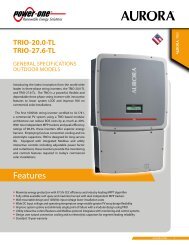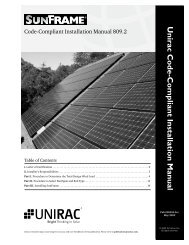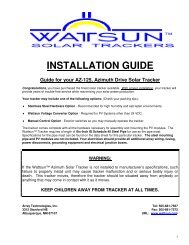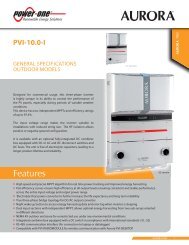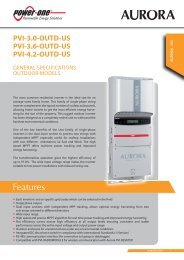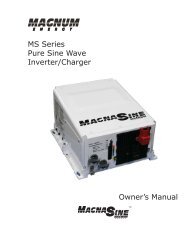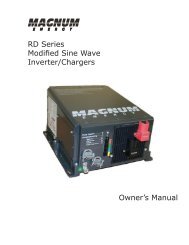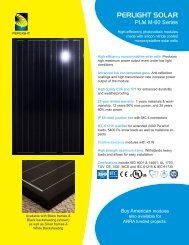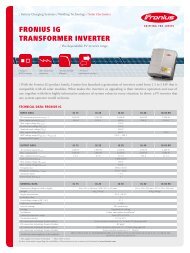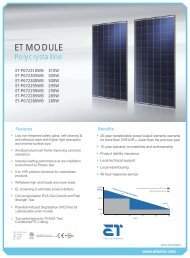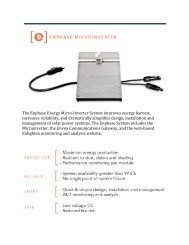AZ-225 Install Manual
AZ-225 Install Manual
AZ-225 Install Manual
You also want an ePaper? Increase the reach of your titles
YUMPU automatically turns print PDFs into web optimized ePapers that Google loves.
7.4) POWER OPTION #2: POWER THE CONTROLLER FROM A 24 or 48 VOLT PV ARRAY<br />
(Array Technologies does not recommend array-direct power connection for Azimuth trackers.<br />
Contact your Dealer for assistance if you are using 24 VDC nominal modules with MC Connectors.)<br />
♦ Array-direct power limits the daily azimuth tracker rotation to 180 degrees or less.<br />
♦ If the installation is for a 48-volt system, then you should use a Wattsun Voltage Converter to reduce<br />
the voltage to the tracker controller and motors.<br />
♦ The positive lead running from the battery bank, to the power input of the controller, should be fused<br />
with a 5 amp, current limiting, DC-rated fuse or equivalent DC breaker.<br />
♦ Failure to fuse the input power wire at the array may create a potential fire hazard.<br />
The input power leads should be connected to a 24-volt nominal PV array. Typically, this will be the output<br />
of two 12-volt PV modules in series. The input voltage should never exceed 50 volts DC and will only<br />
operate when the input voltage is above 23 volts. If the 50 VDC maximum is exceeded, the controller will<br />
be damaged. The damage is not covered under warranty.<br />
Typical Open Circuit Voltage, or Voc, of a 24 VDC array is 44 VDC. A 48 VDC nominal array has a Voc of<br />
88 VDC. Array Technologies manufactures a voltage adapter for PV arrays with voltages over 24 VDC.<br />
Please contact your Dealer if you need the adapter.<br />
When the controller is powered directly from the PV array, the tracker returns to the east in the morning.<br />
The tracker controller automatically adapts to whatever current is available from the PV array. If the PV<br />
array is only capable of producing small amounts of current (20 to 300 milliamps) the tracker will move in<br />
small, pulsed increments. When the array provides over 1/3 an amp (300 ma) of current, the array moves<br />
in a smooth fashion. Typical full east return should occur within 15 minutes after sunrise.<br />
Powering the controller from the array should only be used when limiting the tracker rotation to 180<br />
degrees or less. If the rotation of the tracker is set greater than 180 degrees or if the tracker is not pointed<br />
true South, the tracker will be slow to return to the sunrise position in the morning.<br />
BASIC WIRING DIAGRAM FOR ARRAY DIRECT TO CONTROLLER<br />
28




